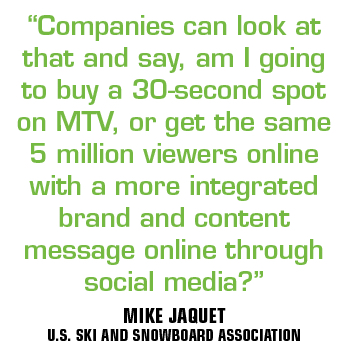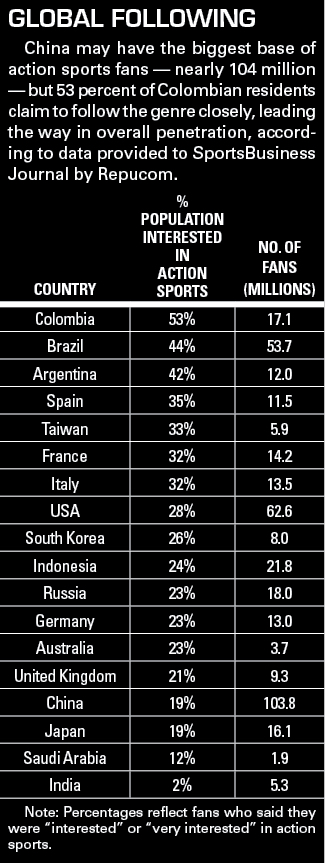Free skier Tom Wallisch has always been part film director, part action sports star. But he took his game to a new level earlier this year.
Wallisch, agent Tom Yaps of Evolution Management & Marketing and production outfit Good Company put together a video of an audacious stunt: Wallisch breaking a world record by sliding 424 feet down an elevated rail on skis.
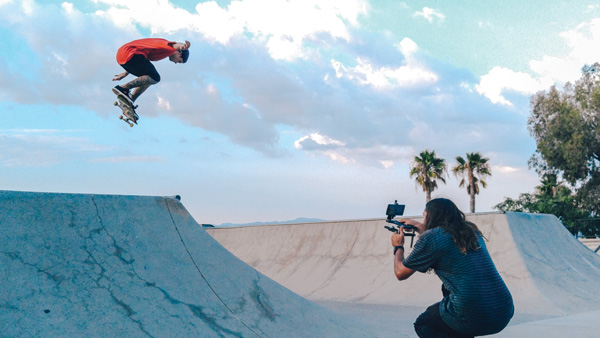 |
Skateboarder Ryan Sheckler goes airborne in a video shot using sponsor LG’s V10 phone.
Photo by: Wasserman |
Nine sponsors signed on, including North Face, Monster Energy and Bose headphones. The footage ran across the usual social media channels, Wallisch and his sponsors’ pages, and by extension was shared by fans worldwide. They also convinced ESPN to feature it on “SportsCenter” and the ABC “World of X Games” Saturday afternoon TV series.
Conservatively estimating, the video has been viewed 10 million times, Yaps said, and sponsors call the project an extraordinary success. It all happened without hiring a film production company or relying on a traditional sport competition platform — just athlete and brands guiding the entire project.
“Five years ago, doing something like this would have been great, and maybe part of it could have gotten on television,” Wallisch said. “But in terms of social, and all this sharing, and in terms of it being viral, it would have been nothing. I think brands would have been very reluctant to get behind such a spend.”
Action sports stars have recorded their own tricks since the earliest days of home video, but something new is afoot in the social/digital/mobile age. The democratization of production and the social internet have combined to lure brand dollars to do-it-yourself content at a pace that’s altering the underlying business model of action sports. Now, instead of creating VHS tapes or DVDs to sell at the end of the year, athletes are finding willing sponsors to foot the bill.
To be sure, content creation has its limits. It’s labor-intensive, and only upper echelon
stars are visible enough to draw a bankable audience on their own. Newcomers still need the visibility offered by traditional events like X Games and the Olympics to break out, and those events still offer nonendemic brands the general interest reach viral videos don’t.
But increasingly, organic content is seen by marketers as a viable, even preferred in some cases, way of reaching the elusive youth-skewing audiences promised by action sports. And while it will never entirely replace the classic sponsorship model, content creation has a prominent seat at the table.
“Certainly there’s a lot to be said for having the winningest guy, the guy or girl on the podium,” said Shay Williams, global sports marketing manager for Monster Energy, a Wallisch sponsor. “But these sports have such a lifestyle — the things you don’t see at the X Games, Dew Tour or the World Cups — and I think we can tap into that because it is cool, and we have the resources to help some of the athletes tell the stories they want to tell.”
Sponsors feel the pull
The branded digital video makes the most sense for companies closest to the sport: makers of endemic action equipment, apparel companies, or headphone and energy drink brands that need to be associated with the culture, said Mike Jaquet, CMO of the U.S. Ski and Snowboard Association.
“Companies can look at that and say, am I going to buy a 30-second spot on MTV, or get the same 5 million viewers online with a more integrated brand and content message online through social media?” Jaquet said.
Agencies that represent athletes are bulking up their production capabilities to compete. In 2015, Wasserman acquired digital agency Laundry Service, which included Cycle, a production house that specializes in viral videos and social influencers.
Cycle recently produced a video with skateboarder Ryan Sheckler, a Wasserman client, using sponsor LG’s V10 phone exclusively to record footage.
Sheckler and his friends took suggestions from fans for where they should attempt tricks around San Clemente, Calif., and recorded it. The end result — part cool tricks footage and all LG advertisement — has been seen 31 million times, not counting millions more seeing the behind-the-scenes and “making of” spinoffs.
“Think about it, you can go to LG, which we did with Sheckler, and get 40-something million views,” said Wasserman managing director Steve Astephen. “Tell me a sport on television that’s getting 44 million people to look at it. I don’t know too many.”
Astephen thinks it’s a financial revolution for athletes and their agents, and production capabilities are a must-have
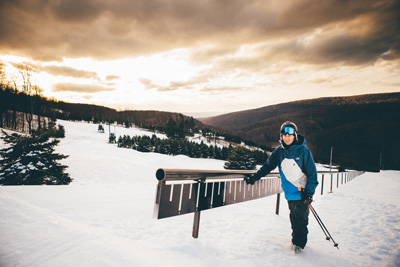 |
Free skier Tom Wallisch stands beside the rail where he performed a record-setting slide.
Photo by: Nick Martini |
for agents. “You don’t have to sponsor an athlete anymore; you can have a media partnership with an athlete,” Astephen said. “That’s the future. And there’s way bigger media and advertising budgets than there are marketing budgets.”
Every brand handles the financing of the athlete content a bit differently, Williams said. Monster starts with conventional sponsorship contracts and then will consider a media production partnership if an athlete pitches it.
Financing comes from a separate, generally larger, media budget, Williams said. “For bigger companies, that’s certainly true,” he said.
Content creation is moving up the list of priorities when brands allocate money to action sports, said Issa Sawabini, partner at Fuse Marketing, a youth-oriented agency that’s represented clients such as Mountain Dew and Hyundai. It’s also changing how athletes spend their time.
“What we’re seeing is more money, effort and time going into this. There’s more resources, and frankly more ways to get visibility for this stuff,” he said. “It used to be these types of things were added after you built your schedule. Now it’s right up in the same tier of importance when you’re building your schedule for the year at the start.”
Trick is in landing views
Like any other digital publisher, though, athletes and brands find that competition for attention is fierce in a cluttered media environment. The same ease of production that’s allowed Sheckler and Wallisch to build video businesses also allows the masses to compete on equal footing.
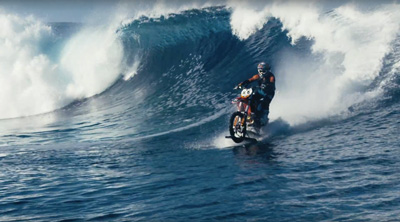 |
DC Shoes sponsored a video of Robbie Maddison riding his specially equipped motorcycle in the ocean water off Tahiti.
Photo by: DC Shoes |
It’s no longer enough to do a cool trick, Sawabini said. With a ready supply of boundary-pushing tricks available on your phone, consumers demand some extra creative energy.
Take, for instance, snowboarding veteran Danny Davis’ Peace Park, a recurring competition inspired by elite athletes’ fatigue with traditional, predictable contests. Davis designed all-new courses, invited only fellow athletes, and eschewed the on-site sponsorship signage and “major event” vibe of crowds, competition bibs and Jumbotrons.
Mountain Dew is the sponsor. The resulting digital video coverage adopts a comedic, laid-back tone that shows off the athletes’ personalities and friendships along with their performances. “Danny doesn’t necessarily go and do a trick that’s never been done before — he’s bringing a whole world that’s never been done before,” Sawabini said.
Videos are a better home for boundary-pushing tricks anyhow, because you’re not risking a medal or sponsor incentives like you are by pushing the envelope at competitions.
To name a few other examples, DC Shoes presented a digital video of dirt bike rider Robbie Maddison riding his
bike across the ocean water off Tahiti, a clip that has gained 22 million views so far. Or rally car racer Ken Block’s Gymkhana series, which has generated tens of millions of YouTube views for presenting sponsors such as DC Shoes and Ford over the years.
Major event properties don’t see the rise in noncompetitive content production as a direct threat, but they are reconsidering what it means to be an event brand. X Games invented the “Real Series” of video-based competitions seven years ago, and two years ago launched “World of X Games,” a weekly TV series. “World of X” still mostly airs X Games’ own content, but it has become another distribution option for athlete-generated ideas.
“A lot of this content is pretty evergreen, so you can put it on the [video-on-demand] channels, the other distribution platforms after it airs,” said Tim Reed, ESPN’s X Games vice president. “So it has long-tail impact after it airs on our network.”
Just this year, The Enthusiast Network, the Dew Tour’s new operating partner, worked with sponsor Mountain Dew to begin building a more robust dewtour.com. The site will aim to be a 24/7 outlet for action sports video, including editorial video created by the TEN team and brand content created with other sponsors.
The next frontier for DIY content is live, thanks to Facebook Live and Periscope, Yaps said. No one knows for sure where it’s going, but those technologies will open another avenue for athletes and brands to work together to reach audiences without third parties, he said. In turn, that will keep the event properties under extraordinary pressure to keep innovating, because if fans or athletes sense them growing stale, they can just go to YouTube to see something new.
Video production isn’t for everybody; it takes a fair bit of entrepreneurial spirit, and many action stars just want to compete and win. But it’s a new path for those who want it, Monster’s Williams said.
“Part of the appeal is that there can only be one guy who wins the X Games every year, but there can be five, 10 or 20 guys who do really well in the media space,” he said. “I think people see it as another avenue to success.”



